Spring is in the air, which means that it’s time to stock up on the season’s wonderful array of fruits and vegetables like crisp asparagus, tangy rhubarb, peppery radishes, and so much more! With all these exciting options, it’s easy to spend your whole budget on produce alone. However, with a little planning and some smart shopping strategies, you can enjoy the best spring has to offer without breaking the bank. Discover some of our favorite tips for how to get the most out of your produce.
1. Use the whole item
take advantage of the entire item. Cook with scraps you’d normally throw away or create stock for soups and stews. You can add overripe fruit to smoothies and baked goods, as well as use them to prepare marinades, sauces, and even salad dressing.
2.Grow in addition to buying
One of the best ways to save money is by supplementing your produce purchases by regrowing things like celery or green onions in your backyard or on your balcony. Not only will you save, but you’ll also know exactly where your food is coming from. Buying herb plants instead of pre-packaged at the store will also help cut costs!
3.Meal prep
Planning your meals in advance can help you make the most of the produce you buy. By knowing what you’re going to make for dinner throughout the week, you can purchase what you need without overbuying and avoid waste. If you find yourself with leftovers after a meal, get creative in the kitchen and use them to whip up another delicious dish!
4.Purchase “ugly” produce
Shopping on a budget doesn’t mean you have to sacrifice the flavor. We recommend looking for discounted produce that is considered bruised, squished, or oddly shaped. Imperfect can still taste just as good for a fraction of the cost.
5.Buy in bulk
Buying large amounts of fruit and veggies is more affordable, especially for produce that lasts longer such as potatoes, carrots, and apples, as well as things that are currently in season. They tend to be cheaper, so make sure to stock up on them and freeze for later use.
6.Shop for Sales
Many grocery stores have weekly deals and discounts on a variety of produce. Save time on your next trip by looking online for sales and ads beforehand and plan ahead. We also recommend following the store on social media to stay updated on the latest offers so you’re able to get even more bang for your buck.
7.Buy Frozen
Frozen produce is often cheaper than fresh and can be just as nutritious. Since it’s flash frozen at peak quality, the taste is practically the same when used in soups, baked goods, and stews. Plus, it lasts longer, which means you don’t have to worry about it going bad before you can use it, and most are cut up already so there’s no need to spend time on prep. Feeling inspired? Learn how to meal prep with frozen foods.
8.Eat the most perishable things first
Organize your fridge by putting the items that will ripen and wilt the fastest into one section. This way you’ll prioritize what to eat or cook first in order to prevent food waste and losing money on groceries.




